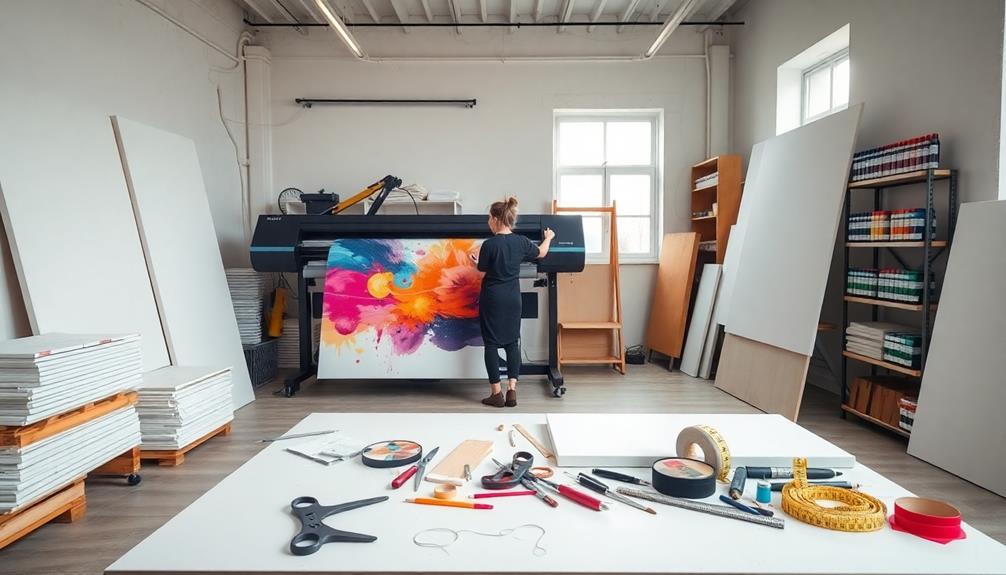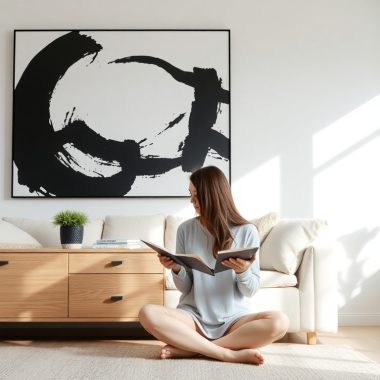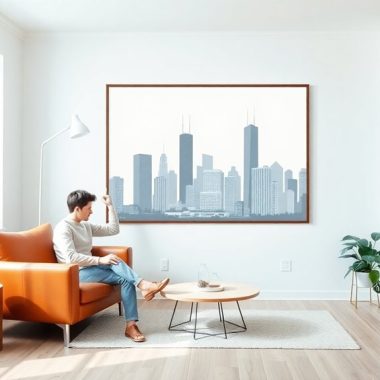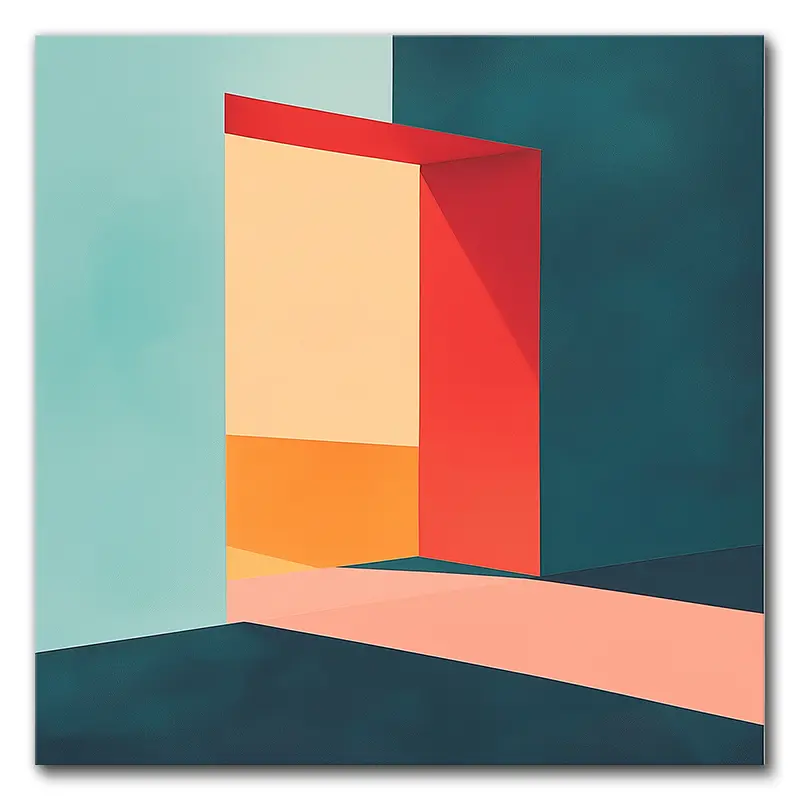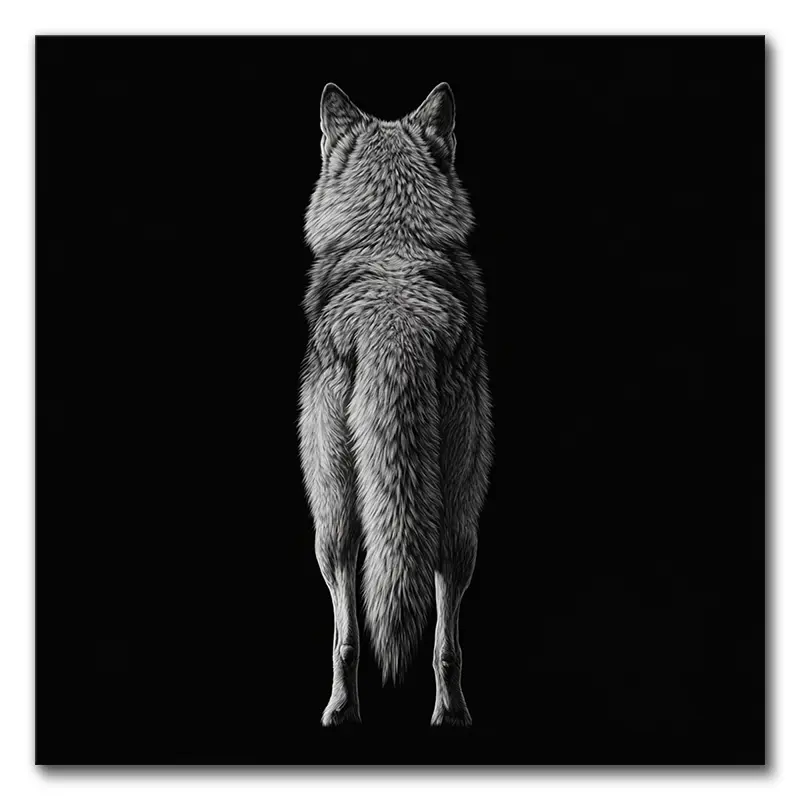Canvas art comes to life through a precise printing process that blends technology with creativity. You start by selecting a high-resolution image, ideally at least 300 DPI, to guarantee clarity. That image undergoes digital processing, where colors and contrasts are fine-tuned, like an artist adjusting their palette. Specialized inkjet printers spray archival-quality inks onto canvas, producing vibrant and durable results. Once printed, the canvas is stretched over a wooden frame and protected with coatings to resist fading and damage. With all these steps, your canvas art isn't just décor; it's a fascinating piece ready to grace your wall with charm. Stick around for more fascinating details!
What Is Canvas Art?
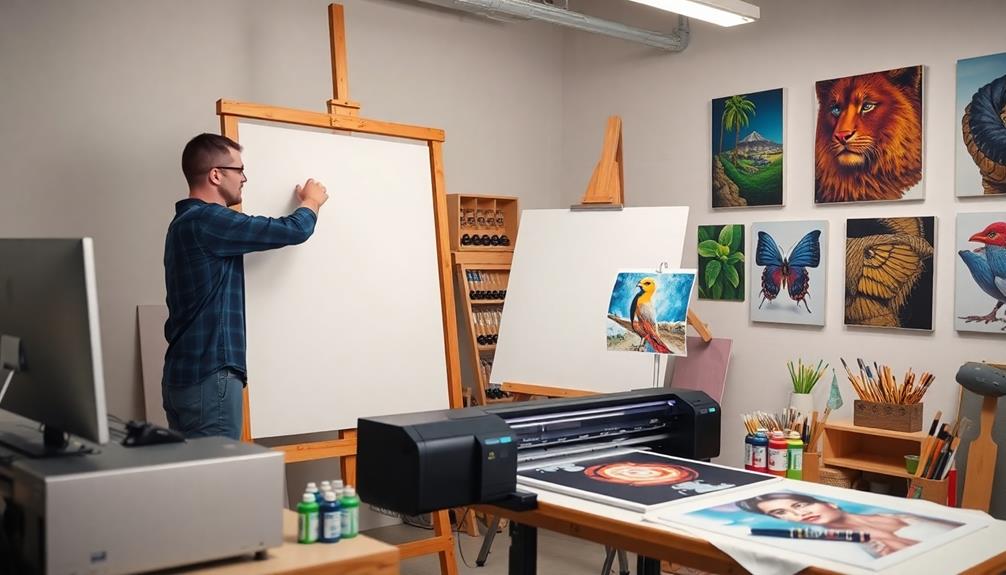
When you think of canvas art, you're likely envisioning vibrant reproductions or original pieces printed on a textured, durable surface. This type of art, known for its unique appeal, involves a fascinating process called canvas printing.
Artists and photographers alike often choose to print on canvas because it adds depth and character to their creations. The canvas material, usually made from cotton, polyester, or a blend, provides that perfect backdrop, allowing colors to pop while maintaining a striking texture. Unlike traditional photo prints, canvas prints are also more resistant to wear and fading, making them a long-lasting choice for displaying art canvas durability.
To create custom canvas prints, high-quality inkjet printers are employed, utilizing archival inks that guarantee your artwork remains vibrant for years to come. The giclée printing technique is particularly remarkable; it offers exceptional color accuracy and detail, making it a favorite for both fine art and photographic reproductions.
Once the image is printed, it's often stretched over a wooden frame using methods like gallery wrapping. This technique not only enhances the artwork's appearance but also creates a clean, frameless look that's quite popular in modern decor.
With the right care—think avoiding direct sunlight and applying UV protective coatings—your canvas art can last over 100 years, which is longer than most of us can keep a New Year's resolution!
The Importance of High-Resolution Images

When it comes to creating stunning canvas art, image quality isn't just a minor detail—it's the foundation of your masterpiece.
You'll want to make sure you're working with high-resolution images, ideally at least 300 DPI, because anything less can lead to an unfortunate case of pixelation that'll have your artwork looking more like a blurry puzzle than a striking visual.
Image Quality Matters
To achieve stunning canvas prints, high-resolution images are essential. When you're preparing your masterpiece, aim for a minimum of 300 DPI (dots per inch).
Why? Because lower resolutions can lead to pixelation—imagine transforming a crisp photo into a blurry mess, like trying to watch a movie on an old, fuzzy TV. For larger canvases, the stakes get even higher; you need to bump up the resolution to maintain that image integrity, ensuring your artwork remains sharp and vibrant, regardless of size.
If you're sourcing images directly from your digital devices, take a moment to check their resolution. Many of them can be transformed into beautiful canvas prints if they meet the necessary standards.
Opt for high-quality file formats, like TIFF or PNG, as they're designed to retain detail during the printing process—think of them as the superhero of image formats, ready to save your art from mediocrity.
Resolution and Print Clarity
Resolution plays an essential role in achieving print clarity, especially for canvas art. When you're crafting a masterpiece, you need to take into account that high-resolution images—ideally at a minimum of 300 DPI (dots per inch)—are critical for ideal print clarity.
Imagine trying to enlarge a low-resolution image; it's like trying to stretch a rubber band too far—you'll end up with pixelation and a muddled mess instead of the vibrant artwork you envisioned.
As your canvas size increases, the required resolution must also rise to maintain that detail and sharpness, creating a delicate balance between size and clarity. Higher DPI guarantees that your artwork retains its intricate details and color accuracy during the printing process, resulting in a true-to-life reproduction that can dazzle viewers.
Before you hit that print button, it's essential to check and adjust your image resolution. Scaling up a low-resolution image is like trying to put a square peg in a round hole; it simply doesn't work well, and the final product often suffers in quality.
Digital Processing Techniques

When it comes to digital processing techniques for canvas art, you'll want to start with high-resolution images—after all, nobody wants a pixelated masterpiece hanging on their wall!
To guarantee your artwork maintains its vibrant colors and impressive detail retention, it's crucial to adjust colors, brightness, and contrast to make your image pop, making sure it captures the attention of anyone who walks by.
Plus, using the right file formats not only keeps your artwork crisp but also allows for precise cropping and resizing, so it fits your canvas like a glove—no one likes a canvas that doesn't fit, right?
Additionally, considering the craftsmanship and quality of your images can greatly enhance the final product.
Image Selection Criteria
Choosing the right image is crucial for creating stunning canvas art that captivates viewers. To achieve the best print quality, you'll want to select high-resolution images with a minimum of 300 DPI. This guarantees that every detail appears crisp and clear, preventing any unfortunate pixelation – which is about as charming as a sock in a shoe.
Strong composition and good color contrast are equally important, as they enhance the visual impact, drawing the eye and inviting closer inspection.
When you're in the digital processing phase, don't shy away from adjusting brightness, contrast, and color balance; these tweaks can greatly boost the vibrancy and detail of your image, transforming it from drab to fab.
Also, consider the cropping, especially if you're aiming for a gallery or museum wrap; careful framing guarantees that crucial elements remain visible and beautifully positioned.
Lastly, utilize high-quality file formats like TIFF or PNG during your selection process. These formats help retain important details and colors throughout the printing journey, ensuring your canvas art isn't just a pretty face but a true work of art.
Color Adjustment Techniques
Once you've selected the perfect image, the next step involves fine-tuning its colors to make certain it stands out on canvas. This process is where color adjustment techniques come into play, allowing you to enhance brightness, contrast, and color balance, ultimately creating an image that pops.
To achieve ideal color reproduction, you'll generally want a minimum of 300 DPI for high-resolution prints—trust me, your future self will thank you for the clarity.
Using digital tools like Adobe Photoshop or Lightroom, you can make precise corrections to guarantee the desired mood and tone of your artwork is faithfully represented. However, before you rush to print, it's essential to conduct a test print. Colors can behave like chameleons, appearing differently on screen compared to canvas, and you don't want any surprises when it's time to showcase your masterpiece.
Let's not forget the importance of calibrating your monitor. This step is fundamental for making sure that what you see on your screen closely matches the printed output, preventing any discrepancies that might lead to a "What happened?" moment when you reveal your art.
Printing on Canvas: The Basics
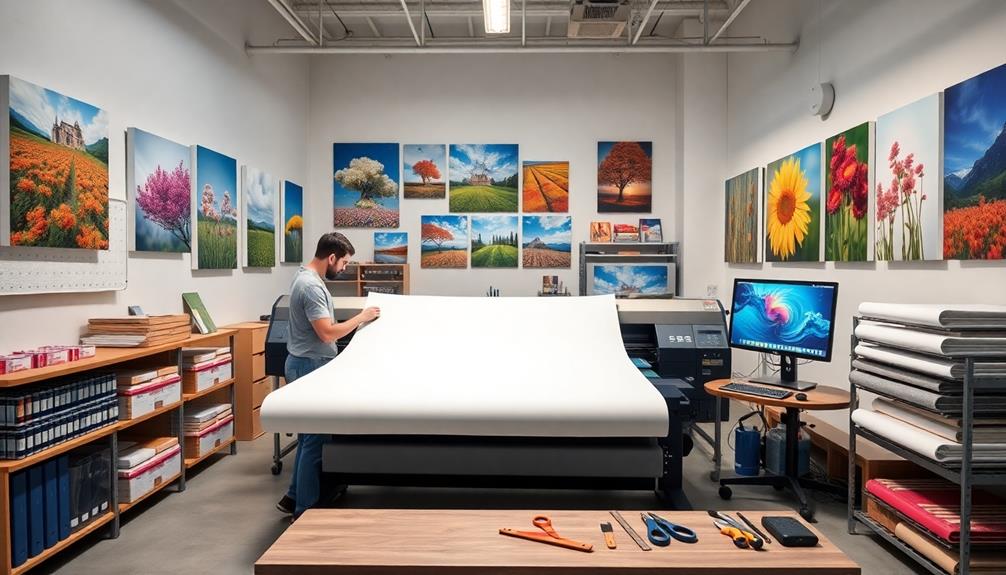
Printing on canvas involves a meticulous process that transforms high-resolution images into stunning works of art. It all begins with selecting an image that boasts at least 300 DPI (dots per inch) to guarantee every detail pops like a fresh batch of popcorn.
Once you've got the perfect image, the magic unfolds through various printing techniques. Understanding the unique charm of canvas prints can enhance your selection process. Here's what you need to know:
- Giclée Printing: This method is renowned for its high color accuracy, making your art look as vibrant as the day it was captured.
- Dye Sublimation: If you're seeking vibrant, durable prints that stand the test of time, this technique is your go-to. It infuses dye into the canvas, creating a striking visual experience.
- Post-Printing Care: After your masterpiece is printed, it's essential to stretch the canvas over a wooden frame. Techniques like Gallery or Museum Wrap not only improve the aesthetic but also preserve the integrity of the artwork.
Once your canvas is framed, don't forget about maintenance! Avoid placing it in direct sunlight and use a soft cloth for cleaning—because nobody wants a faded masterpiece.
By understanding these basics, you can appreciate the artistry behind canvas printing, transforming ordinary images into extraordinary visual stories that adorn your walls.
Specialized Inkjet Printers
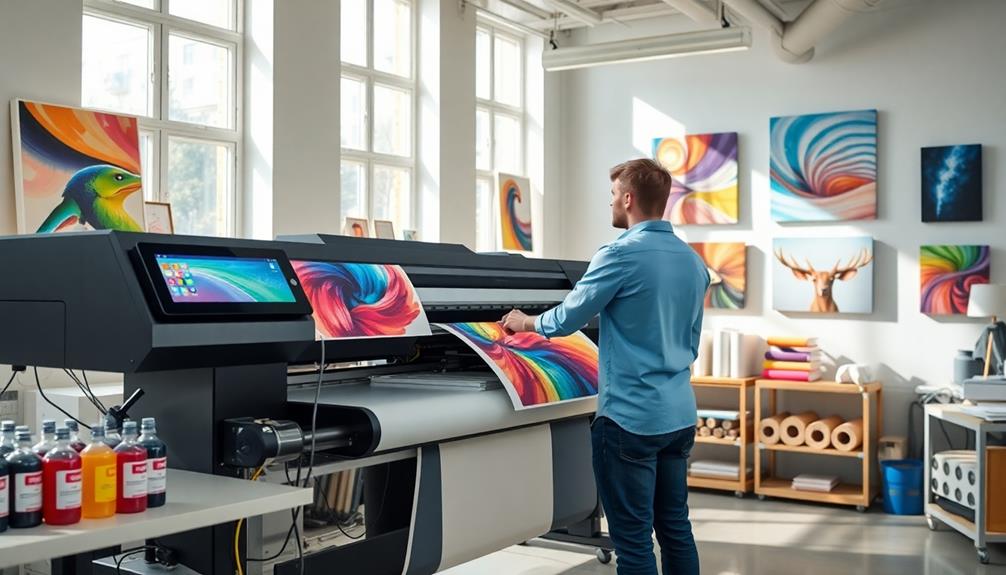
When you think about the magic behind canvas art, specialized inkjet printers play a significant role that's often overlooked, transforming your favorite images into stunning pieces worthy of a gallery wall.
These printers aren't just your average office machines; they're engineered to handle thicker materials like canvas and employ archival-quality inks that resist fading, ensuring your artwork looks as vibrant today as it will in years to come.
With impressive resolutions that can exceed 300 DPI and a wide color gamut that produces rich gradients, these printers might just make you wonder if they possess a little bit of artistic flair themselves—though we can't confirm if they enjoy sipping espresso while they work!
Printer Technology Overview
Specialized inkjet printers play an essential role in the world of canvas art, as they're specifically designed to handle thicker materials while delivering exceptional quality and detail.
These remarkable machines utilize wide-format technology, allowing you to create stunning artworks with incredible precision. If you're curious about what makes these printers stand out, consider the following:
- High Resolution: Operating at resolutions between 1440 to 2880 DPI, these printers guarantee that every brushstroke and detail is captured beautifully, making your prints suitable for fine art and photography.
- Color Management: Advanced color management systems enhance color accuracy and vibrancy. This means your images will leap off the canvas, showcasing rich, lifelike colors that impress viewers.
- Durability: Many canvas printers use archival inks that resist fading, keeping your masterpiece intact for years. Additionally, a unique coating mechanism often protects the printed surface, assuring it withstands moisture and environmental factors.
With such impressive technology at play, it's no wonder that specialized inkjet printers have become a favorite among artists looking to bring their visions to life.
Who knew printers could be so fascinating?
Ink Types Used
The choice of ink plays a vital role in the quality and longevity of canvas prints. When you're selecting a canvas print, consider the type of ink used, as it can make all the difference between a vibrant masterpiece and a faded memory.
Specialized inkjet printers typically employ archival-quality inks, which resist fading and maintain rich colors over time. Among these, pigment-based inks stand out for their superior longevity and color stability, making them particularly ideal for fine art and photography.
You might also encounter eco-solvent inks, which are more environmentally friendly without sacrificing print quality. They deliver durability that guarantees your artwork remains stunning for years to come.
Additionally, water-based inks are popular in the canvas printing industry, offering safe, non-toxic options that still boast clarity and vibrancy.
Advanced printing techniques like Giclée printing utilize a wide color gamut of inks to capture the subtle nuances and intricate details in artwork, assuring that your print reflects the original image with remarkable fidelity.
Print Quality Factors
In the domain of canvas art, print quality hinges on the capabilities of specialized inkjet printers designed specifically for this task.
These printers aren't your average office models; they're wide-format machines built to handle thick materials, ensuring that your artwork looks stunning.
If you're curious about what makes a great print, consider these factors:
- Archival Inks: These fade-resistant inks provide vibrant color reproduction, ensuring that your canvas art remains visually striking for years.
- Resolution: A minimum resolution of 300 DPI is required to maintain clarity and detail, so your artwork doesn't turn into a pixelated mess.
- Advanced Techniques: Techniques like Giclée printing utilize precise ink droplet technology, achieving rich color accuracy and intricate detail that can make your art truly pop.
Additionally, specialized coatings may be applied post-printing to enhance durability and protect the canvas from environmental factors, ensuring the longevity of the artwork.
Archival Inks and Their Benefits
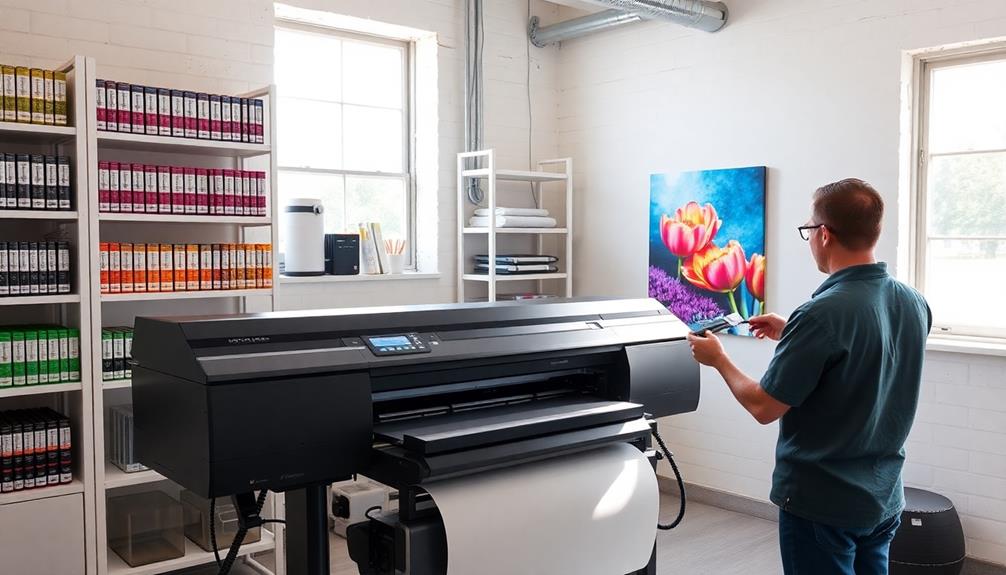
Choosing archival inks for your canvas art can make a significant difference in how long your prints will last. These specially formulated inks resist fading and deterioration, which means your vibrant prints can maintain their brilliance for over 100 years, assuming you give them a little TLC.
Unlike their dye-based counterparts, archival inks are often pigment-based, boasting a wider color gamut and superior lightfastness. This makes them ideal for high-quality art prints that you want to showcase, rather than hide in a dusty attic.
Moreover, archival inks are typically water-resistant, allowing them to withstand environmental factors like humidity or accidental spills—because let's face it, accidents happen. If you're thinking of hanging your masterpiece in a room with a window, you'll appreciate this feature.
Many of these inks are also acid-free, preventing that dreaded yellowing and damage to the canvas material over time, which is essential for preserving the integrity of your artwork. You wouldn't want your prized piece resembling an old newspaper, would you?
Using archival inks aligns with professional printing standards, ensuring that your art meets gallery and museum preservation requirements.
Stretching the Canvas
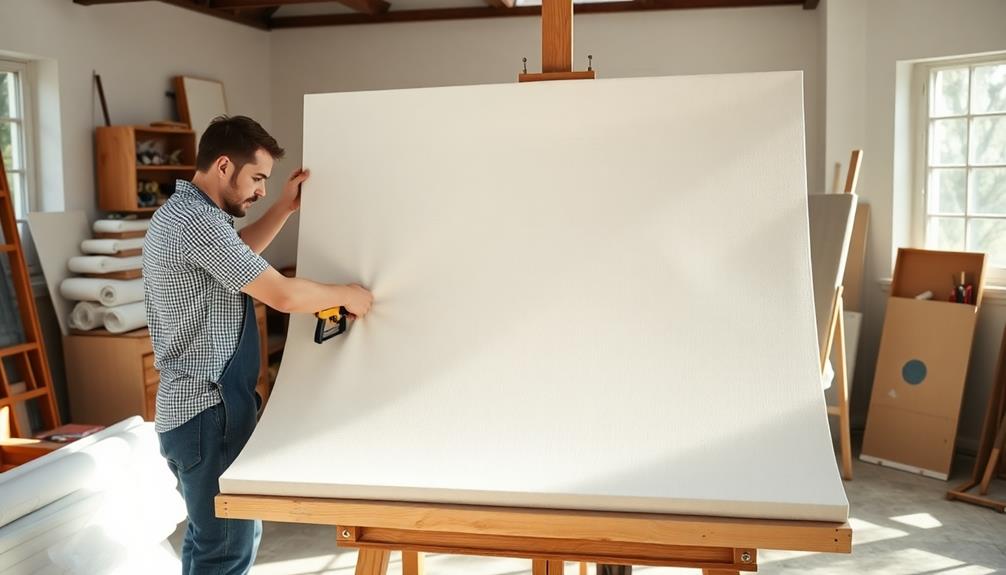
Stretching canvas is an essential step that transforms your printed artwork into a ready-to-hang masterpiece. This process involves pulling the printed canvas tightly over a wooden frame, guaranteeing a smooth and taut surface that enhances the visual appeal of your piece.
The most common technique used is the Gallery Wrap, which allows the artwork to wrap around the edges of the frame, making it visible from all angles—a truly immersive experience for viewers.
To guarantee a flawless finish, consider these key aspects of stretching canvas:
- Secure the Canvas: Using a staple gun or tacks, attach the canvas to the back of the frame. This prevents any unsightly sagging or distortion that could ruin your artwork's aesthetic appeal.
- Choose the Right Frame Thickness: Generally, frames range from 1.5 to 2 inches thick. This substantial depth not only adds a professional touch but also enhances the artwork's overall impact, making it stand out on your wall.
- Opt for Acid-Free Materials: During the stretching process, using acid-free materials is vital. This precaution helps protect your canvas from damage or discoloration over time, making sure your masterpiece retains its brilliance.
As you commence this stretching journey, remember that attention to detail is key. With the right techniques and materials, your printed canvas will soon command attention, becoming a focal point in any room—no pressure, right?
Applying Protective Coatings
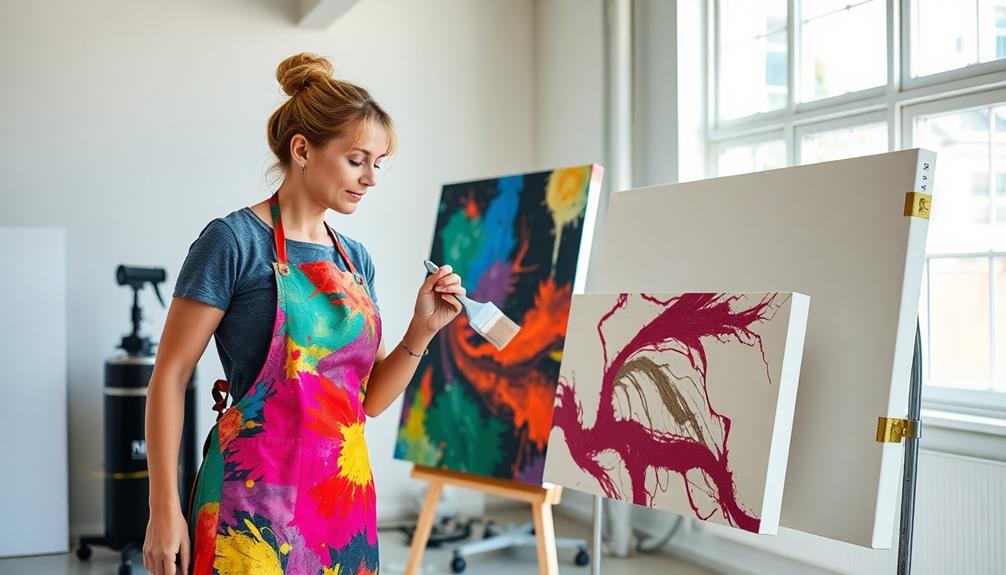
Applying protective coatings to your canvas prints is fundamental for preserving their beauty and longevity. These coatings serve as a essential barrier against moisture, UV rays, and dust, which can wreak havoc on your artwork over time.
Imagine your vibrant colors fading away like a forgotten childhood memory—no one wants that! Common types of protective coatings include UV protective sprays and varnishes, which are like sunscreen for your art, preventing fading and discoloration while keeping the colors as lively as the day they were printed.
When you're ready to apply these coatings, you'll find they come in various finishes—matte, satin, or glossy—allowing you to customize the look of your canvas to match your personal style.
Just picture your artwork glistening under the light or having a sleek, understated charm! However, it's imperative to do this in a well-ventilated area to avoid inhaling any fumes. Always follow the manufacturer's instructions for best results; you wouldn't want to ruin your masterpiece with an overzealous spray, right?
Regular maintenance is also key. A gentle dusting here and there, along with the occasional reapplication of those protective coatings, keeps your canvas print in pristine condition.
Think of it as giving your artwork a spa day every now and then. By taking these simple steps, you can guarantee your canvas prints remain a source of joy and admiration for years to come.
Finishing Touches for Ready-to-Hang Art
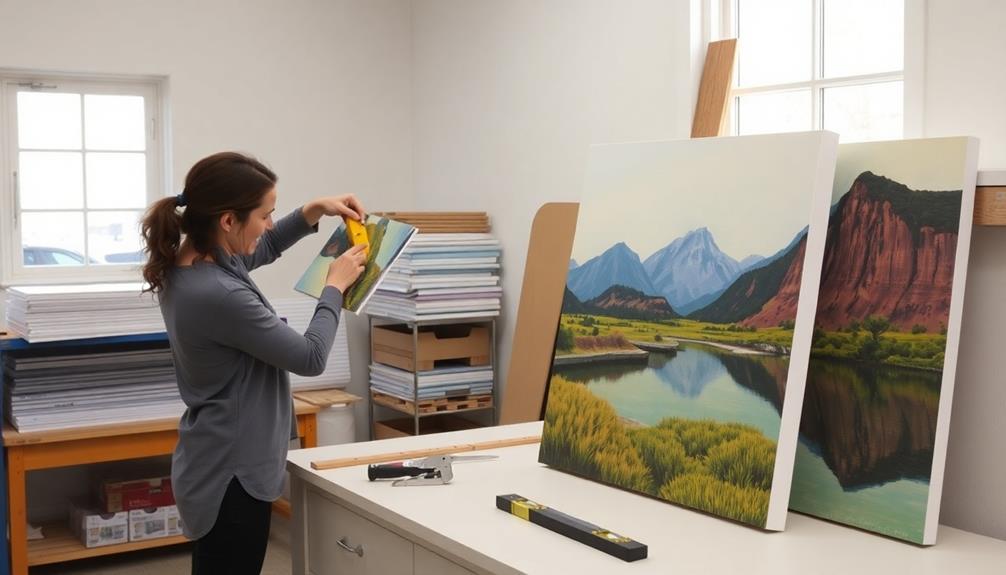
The final touches on your canvas art can transform a simple print into a stunning, ready-to-hang masterpiece. After the printing process, the canvas is typically stretched over a sturdy wooden frame. Techniques like Gallery Wrap or Museum Wrap not only enhance the aesthetic but also provide that professional finish you're aiming for.
Here are three key finishing touches to think about:
- Protective Coatings: Adding UV-protective clear coats enhances durability, guaranteeing that those vibrant colors don't fade away faster than your enthusiasm during a long lecture.
- Hanging Hardware: To make mounting as easy as pie, D-rings or sawtooth hangers are affixed to the back of your canvas. This way, you won't need to channel your inner architect just to hang your art.
- Corner Braces: These nifty little additions bolster the integrity and tension of the canvas, preventing sagging that might make your masterpiece resemble a deflated balloon.
Lastly, before you proudly display your work, give the surface a gentle dusting or a wipe with a soft, lint-free cloth. This guarantees that your artwork is pristine and ready for admiration.
With these finishing touches, your canvas art not only serves as a visual delight but also stands the test of time, looking magnificent on your walls for years to come.
Caring for Your Canvas Art
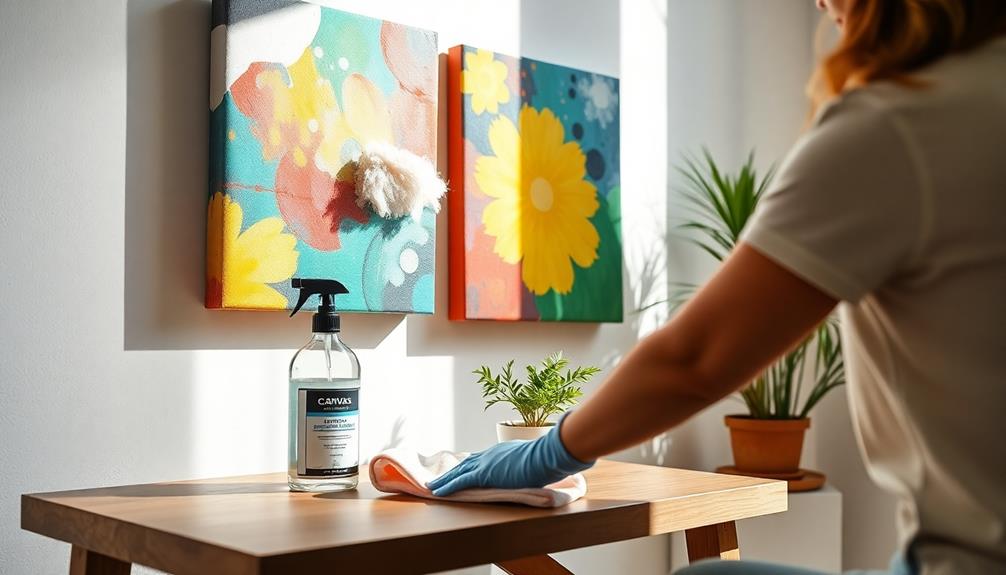
Canvas art deserves the same care and attention you give to any cherished piece in your home. After all, these vibrant creations aren't just decorations; they're windows into your imagination. To guarantee their longevity, keep them out of direct sunlight, as prolonged exposure can lead to fading and discoloration, transforming those brilliant colors into a dull memory.
Regular dusting is essential, so grab a soft, lint-free cloth and give those canvases a gentle wipe. Think of it as a spa day for your art—refreshing yet careful. If you encounter smudges or stains, use a slightly damp cloth to tackle them. Remember to avoid harsh chemicals or abrasives, which might turn your masterpiece into a canvas of regrets.
Consider applying a UV protective clear coat; it's like sunscreen for your art, reducing fading while creating a barrier against dirt and moisture. Now, imagine your beautiful print sitting in a dust-free haven, sparkling as if it just came out of the box.
When it comes to storage, treat your canvases well. Store them upright rather than stacked, which helps prevent warping and protects the edges. After all, you wouldn't want your treasured art pieces to end up in the "oops, I stacked them" saga.
Frequently Asked Questions
How Are Canvas Art Prints Made?
Canvas art prints are made by selecting a high-quality image, adjusting it for ideal brightness and color, then printing directly onto canvas with specialized ink. Finally, you stretch it over a frame for a polished finish.
What Are the Methods of Canvas Printing?
When you're capturing dreams on canvas, consider methods like Giclée for vivid detail, Dye sublimation for lasting impressions, or Print on Demand for tailored elegance. Each technique transforms your vision into a timeless masterpiece.
How Are Art Canvases Made?
To make art canvases, you start with durable fabric, stretch it over a frame, and prepare it for printing. Then, you print your design using specialized inks, adding protective coatings for longevity and vibrancy.
How Do I Turn My Canvas Art Into Prints?
You know what they say: a picture's worth a thousand words. To turn your canvas art into prints, scan or photograph it at high resolution, adjust colors, and choose a reputable printing service for the best results.
Final Thoughts
In the intricate dance of canvas art creation, where high-resolution images meet specialized inkjet printers, a world of vibrant colors and textures emerges, inviting your gaze. You might marvel at the contrast between the raw canvas and the finished masterpiece, each step—from digital processing to protective coatings—ensuring longevity and beauty. So, whether you're admiring a striking landscape or a whimsical abstract, remember, the journey from digital file to wall-ready art is as fascinating as the art itself. At VerVeLush, we share this passion for canvas prints, offering expertly crafted pieces that elevate any space. Explore our collection to discover how our unique selections can transform your walls into a vibrant gallery of art.

